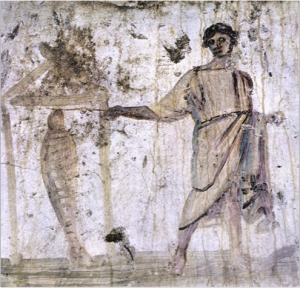You start to notice this focus on Lazarus in the earliest centuries of Christianity through the art. In the Roman catacombs alone there are over 55 paintings of Lazarus’s resurrection. Roughly an equal number exist of Roman sarcophagi, the marble caskets in which nobility were buried, depicting this life-affirming story relayed only in John’s Gospel. And then there are the dozens more depictions of Jesus’ friend rising from his grave–on ivory, glass and metal objects that didn’t have anything to do with funerals.

The Good Shepherd Catacomb of Saints Peter and Marcellinus, Rome, showing Jesus raising Lazarus from his tomb.
Perhaps all these artistic renderings of Lazarus’ emergence from his tomb three days after his burial are the reason behind historians’ belief that the raising of Jesus’ good friend, made a deeper impression on early Christians than almost any other New Testament text.
Maybe this doesn’t match your own experience of looking at Christian religious art in the world’s great museums. After all, the paintings of Mary and the baby Jesus predominate, along with those of the crucifixion and resurrection. But this is medieval art.
So why was the Lazarus story so key for early Christians and what can we learn from this? And if it was so impactful, why did Lazarus’ rising appear only in John’s Gospel? Is there a role the Lazarus story plays for John that sheds light on the rest of the Gospel of John? These are the kinds of questions that cause us to don our spiritual detective hats and result in fresh inspiration to even the most familiar of stories.
Because John’s Gospel, like the others, is told in chronological order, paying attention to where the Lazarus story appears in relation to the whole, makes sense. You’ll probably want to get your Bible and look it up.
Ok, so you found it was Chapter 11, the approximate halfway point in John’s 21 chapters. (If you’re studying a Biblical book with friends in a Bible Study group, or on your own, one of the joys is reading chapter by chapter and finding inspiration in why a certain story appears where it does.) In the case of the Gospel of John, this story of the raising of Lazarus serves as a catalyst leading up to Jesus’ own death and resurrection. (The synoptic Gospels of Matthew, Mark and Luke also contain a story of Jesus’ raising the dead, but in those three cases it is Jairus’ daughter (Matt. 9:18-26, Mark 5:21-43 and Luke 8:40-56.)
You may recall that the ‘miracles’ or healings referred to in the other gospels are called ‘signs’ in John’s Gospel. There are seven signs, and the story of Lazarus illustrates the final one: the resurrection and the life. John 11 and the following chapter of John 12 act like a literary bridge between Jesus’ ministry with others and his own final demonstration that God indeed provides eternal life. The Lazarus story lays down a bridge of faith and understanding that we can walk across to understand more the Master’s own death and resurrection.
As we approach Easter, let’s ponder this Lazarus story and see what it can teach us about eternal life. For instance, in the first section, (Introduction and Lazarus’ illness and eventual death – verses 1-16), Jesus responds to Mary and Martha’s message that their brother is ill and would Jesus please come. Explaining that “this illness does not lead to death; rather it is for God’s glory, so that the Son of God may be glorified through it” (John 11:4), the Master could have been referencing his own coming death and resurrection.
Next, lest the reader miss another hint of the story’s preparation for Jesus’ own resurrection, the author identifies Lazarus’ sister, Mary, as the one who will anoint Jesus’ feet with her hair, an act interpreted as preparing his body for burial (see John 11:2). In doing this, Jesus changes the focus from sickness to spiritual revelation, from death to eternal life. This is the very glory that will be thoroughly illustrated in the Master Christian’s upcoming crucifixion, resurrection and ascension, as John 11:4 above indicates.
The other two parts of this key story include a) the plans to raise Lazarus (verses 17-37) and b) Lazarus raised from the dead (verses 38-44 (end). Let’s keep our‘spiritual detective’ work going and look for additional ways in these verses that Lazarus’ release from the tomb foreshadows Christ Jesus’ triumph. What a way to celebrate Easter. He is indeed risen!




Madelon, this is a wonderful article. It inspires me to see the risen Christ in each of us!
Thank you Maddy for this Easter blessing. I always learn something new from what you share but more importantly there is new inspiration to ponder.
Great piece Madelon,
I like looking at Lazarus’ resurrection as a preparation for readers to be open to Jesus’ resurrection. You leave a nice trail of clues to substantiate your argument.
Happy Easter–He is risen!
Tom
I would use rising Lazarus from the dead as a sample for the Christian to understand that if we follow the direction according to God plan then it will happen to us when the times come.
Thank you for this article. I enjoy your writing.
Hi
Why Lazarus resurection was more important and more known and more dangerous to the Jewish leaders than Tabitha, Eutychus,